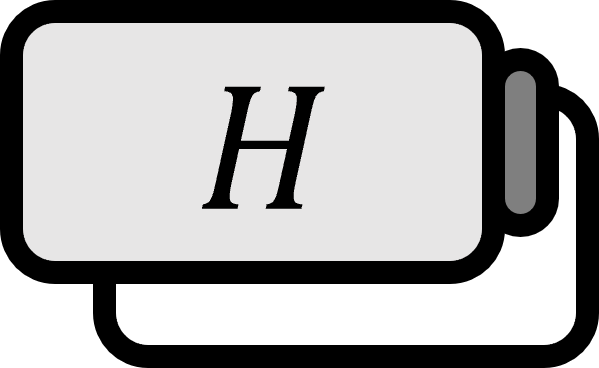Hilbert Space to L2 Space: The Adjoint Operator
Theorem1
Let $\left\{ \mathbf{v}_k \right\}_{k \in \mathbb{N}}$ be a sequence defined in a Hilbert space $H$. Let a bounded linear operator $T : \ell^{2} \to H$ be defined as follows.
$$ T \left\{ c_{k} \right\}_{k \in \mathbb{N}} := \sum_{k=1}^{\infty} c_{k} \mathbf{v}_{k} $$
Then, the adjoint operator $T^{ \ast } : H \to \ell^{2}$ of $T$ is represented as follows.
$$ T^{ \ast } \mathbf{v} = \left\{ \left\langle \mathbf{v} , \mathbf{v}_{k} \right\rangle_{H} \right\}_{k \in \mathbb{N}} $$
Moreover, for all $\mathbf{v} \in H$,
$$ \sum_{k=1}^{\infty} \left| \left\langle \mathbf{v} , \mathbf{v}_{k} \right\rangle_{H} \right|^{2} \le \left\| T \right\|^{2} \left\| \mathbf{v} \right\|_{H}^{2} $$
And likewise, for all $\mathbf{v} \in H$,
$$ TT^{ \ast } \mathbf{v} = \sum_{k \in \mathbb{N}} \left\langle \mathbf{v} , \mathbf{v}_{k} \right\rangle_{H} \mathbf{v}_{k} , \qquad \mathbf{v} \in H $$
Explanation
The space $\ell^{2}$ is of significant importance among $l^{p}$ spaces because it possesses an inner product, not just being an example of $p=2$ but becoming a particularly important case in the Banach space, which deals with functionals. Especially because it is isometrically isomorphic to separable Hilbert spaces, it’s very important.
Proof
From the definition of $T$,
$$ \left\langle \mathbf{v} , T \left\{ c_{k} \right\}_{k \in \mathbb{N}} \right\rangle_{H} = \left\langle \mathbf{v} , \sum_{k=1}^{\infty} c_{k} \mathbf{v}_{k} \right\rangle_{H} = \sum_{k=1}^{\infty} \overline{c_{k}} \left\langle \mathbf{v} , \mathbf{v}_{k} \right\rangle_{H} $$
Since $T^{ \ast } : H \to \ell^{2}$ maps an element of $\mathbf{v} \in H$ to some sequence $\left( T^{ \ast } \mathbf{v} \right)_{k} \in \ell^{2}$, it can be represented as follows.
$$ T^{ \ast } \mathbf{v} = \left\{ \left( T^{ \ast } \mathbf{v} \right)_{k} \right\}_{k \in \mathbb{N}} $$
Since the operator is linear and bounded,
$$ \left\| T^{ \ast } \mathbf{v} \right\|_{2} = \left( \sum_{k=1}^{\infty} \left| \left( T^{ \ast } \mathbf{v} \right)_{k} \right|^{2} \right)^{1/2} \le \left\| T^{ \ast } \right\| \left\| \mathbf{v} \right\|_{H} $$
This implies the following for all $k \in \mathbb{N}$.
$$ \left\| \left( T^{ \ast } \mathbf{v} \right)_{k} \right\|_{2} \le \left\| T^{ \ast } \right\| \left\| \mathbf{v} \right\|_{H} $$
In other words, the mapping $\mathbf{v} \mapsto \left( T^{ \ast } \mathbf{v} \right)_{k}$ is bounded for all $k \in \mathbb{N}$.
Let $H$ be a Hilbert space. There exists a unique $\mathbf{w} \in H$ satisfying $f ( \mathbf{x} ) = \left\langle \mathbf{x} , \mathbf{w} \right\rangle$ and $\| f \|_{H^{\ast}} = \| \mathbf{w} \|_{H}$ for the linear functional $f \in H^{ \ast }$ and $\mathbf{x} \in H$ in $H$.
$$ \left( T^{ \ast } \mathbf{v} \right)_{k} = \left\langle \mathbf{v} , \mathbf{w}_{k} \right\rangle_{H} $$
Therefore, according to the Riesz Representation Theorem, there must exist $\mathbf{w}_{k} \in H$ satisfying the following. This means that $T^{ \ast } \mathbf{v}$ can be represented like this for some $\left\{ \mathbf{w}_k \right\}_{k \in \mathbb{N}} \subset H$.
$$ T^{ \ast }\mathbf{v} = \left\{ \left\langle \mathbf{v} , \mathbf{w}_{k} \right\rangle_{H} \right\}_{k \in \mathbb{N}} $$
Then, according to the definition of $T^{ \ast }$,
$$ \begin{align*} \sum_{k=1}^{\infty} \overline{c_{k}} \left\langle \mathbf{v} , \mathbf{v}_{k} \right\rangle_{H} =& \left\langle \mathbf{v} , T \left\{ c_{k} \right\}_{k \in \mathbb{N}} \right\rangle_{H} \\ =& \left\langle T^{ \ast } \mathbf{v} , \left\{ c_{k} \right\}_{k \in \mathbb{N}} \right\rangle_{\ell^{2}} \\ =& \left\langle \left\{ \left\langle \mathbf{v} , \mathbf{w}_{k} \right\rangle_{H} \right\}_{k \in \mathbb{N}} , \left\{ c_{k} \right\}_{k \in \mathbb{N}} \right\rangle_{\ell^{2}} \\ =& \sum_{k=1}^{\infty} \overline{c_{k}} \left\langle \mathbf{v} , \mathbf{w}_{k} \right\rangle_{H} \end{align*} $$
Summarizing,
$$ \sum_{k=1}^{\infty} \overline{c_{k}} \left\langle \mathbf{v} , \mathbf{v}_{k} \right\rangle_{H} = \sum_{k=1}^{\infty} \overline{c_{k}} \left\langle \mathbf{v} , \mathbf{w}_{k} \right\rangle_{H} $$
Thus,
$$ T^{ \ast } \mathbf{v} = \left\{ \left\langle \mathbf{v} , \mathbf{w}_{k} \right\rangle_{H} \right\}_{k \in \mathbb{N}} = \left\{ \left\langle \mathbf{v} , \mathbf{v}_{k} \right\rangle_{H} \right\}_{k \in \mathbb{N}} $$
Then, from the properties of the adjoint operator, since $| T | = \left\| T^{ \ast } \right\|$ and $T^{ \ast }$ is bounded,
$$ \left\| T^{ \ast } \mathbf{v} \right\|_{\ell^{2}}^{2} \le \left\| T^{ \ast } \right\|^{2} \left\| \mathbf{v} \right\|_{H}^{2} \le \left\| T \right\|^{2}\left\| \mathbf{v} \right\|_{H}^{2} $$
If rewritten in series form,
$$ \sum_{k=1}^{\infty} \left| \left\langle \mathbf{v} , \mathbf{v}_{k} \right\rangle_{H} \right|^{2} \le \left\| T \right\|^{2} \left\| \mathbf{v} \right\|_{H}^{2} $$
Finally, from $T \left\{ c_{k} \right\}_{k \in \mathbb{N}} := \sum_{k=1}^{\infty} c_{k} \mathbf{v}_{k}$ and $T^{ \ast } \mathbf{v} = \left\{ \left\langle \mathbf{v} , \mathbf{v}_{k} \right\rangle_{H} \right\}_{k \in \mathbb{N}}$,
$$ TT^{ \ast } \mathbf{v} = \sum_{k \in \mathbb{N}} \left\langle \mathbf{v} , \mathbf{v}_{k} \right\rangle_{H} \mathbf{v}_{k} , \qquad \mathbf{v} \in H $$
■
Ole Christensen, Functions, Spaces, and Expansions: Mathematical Tools in Physics and Engineering (2010), p75-76 ↩︎
